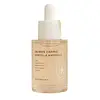What's inside
What's inside
 Key Ingredients
Key Ingredients

 Benefits
Benefits

 Ingredients Side-by-side
Ingredients Side-by-side

Helianthus Annuus Seed Oil
EmollientAcrylates/C10-30 Alkyl Acrylate Crosspolymer
Emulsion StabilisingArginine
MaskingTocopherol
AntioxidantAdenosine
Skin ConditioningCeramide NP
Skin ConditioningAdansonia Digitata Seed Oil
EmollientDisodium EDTA
Hydrogenated Lecithin
EmulsifyingSqualane
EmollientAllantoin
Skin ConditioningLactobacillus/Soymilk Ferment Filtrate
Skin ConditioningPanthenol
Skin ConditioningPolyglucuronic Acid
Skin ConditioningCollagen Amino Acids
MoisturisingCeramide As
Skin ConditioningCeramide Ns
Skin ConditioningButylene Glycol
HumectantPentylene Glycol
Skin ConditioningCeramide AP
Skin ConditioningCeramide EOP
Skin ConditioningHaematococcus Pluvialis Extract
AntioxidantCentella Asiatica Extract
CleansingPanax Ginseng Root Extract
EmollientCopper Tripeptide-1
Skin ConditioningAcetyl Hexapeptide-8
HumectantSodium Dna
Skin ConditioningHelianthus Annuus Seed Oil, Acrylates/C10-30 Alkyl Acrylate Crosspolymer, Arginine, Tocopherol, Adenosine, Ceramide NP, Adansonia Digitata Seed Oil, Disodium EDTA, Hydrogenated Lecithin, Squalane, Allantoin, Lactobacillus/Soymilk Ferment Filtrate, Panthenol, Polyglucuronic Acid, Collagen Amino Acids, Ceramide As, Ceramide Ns, Butylene Glycol, Pentylene Glycol, Ceramide AP, Ceramide EOP, Haematococcus Pluvialis Extract, Centella Asiatica Extract, Panax Ginseng Root Extract, Copper Tripeptide-1, Acetyl Hexapeptide-8, Sodium Dna
Centella Asiatica Leaf Water
Skin ConditioningButylene Glycol
HumectantWater
Skin ConditioningPropanediol
Solvent1,2-Hexanediol
Skin ConditioningGlycerin
HumectantSodium Dna
Skin ConditioningSalmon Egg Extract
Madecassoside
AntioxidantPortulaca Oleracea Water
Skin ConditioningPersea Gratissima Fruit Extract
EmollientMaltodextrin
AbsorbentHyaluronic Acid
HumectantHydrolyzed Hyaluronic Acid
HumectantTheobroma Cacao Extract
Skin ConditioningChenopodium Quinoa Seed Extract
Skin ConditioningHydrolyzed Wheat Protein
Skin ConditioningBetaine
HumectantDextrin
AbsorbentSodium Hyaluronate
HumectantCarbomer
Emulsion StabilisingEthylhexylglycerin
Skin ConditioningAmmonium Acryloyldimethyltaurate/Vp Copolymer
Tromethamine
BufferingDisodium EDTA
Centella Asiatica Leaf Water, Butylene Glycol, Water, Propanediol, 1,2-Hexanediol, Glycerin, Sodium Dna, Salmon Egg Extract, Madecassoside, Portulaca Oleracea Water, Persea Gratissima Fruit Extract, Maltodextrin, Hyaluronic Acid, Hydrolyzed Hyaluronic Acid, Theobroma Cacao Extract, Chenopodium Quinoa Seed Extract, Hydrolyzed Wheat Protein, Betaine, Dextrin, Sodium Hyaluronate, Carbomer, Ethylhexylglycerin, Ammonium Acryloyldimethyltaurate/Vp Copolymer, Tromethamine, Disodium EDTA
 Reviews
Reviews

Ingredients Explained
These ingredients are found in both products.
Ingredients higher up in an ingredient list are typically present in a larger amount.
Butylene Glycol (or BG) is used within cosmetic products for a few different reasons:
Overall, Butylene Glycol is a safe and well-rounded ingredient that works well with other ingredients.
Though this ingredient works well with most skin types, some people with sensitive skin may experience a reaction such as allergic rashes, closed comedones, or itchiness.
Learn more about Butylene GlycolDisodium EDTA plays a role in making products more stable by aiding other preservatives.
It is a chelating agent, meaning it neutralizes metal ions that may be found in a product.
Disodium EDTA is a salt of edetic acid and is found to be safe in cosmetic ingredients.
Learn more about Disodium EDTASodium DNA is an emerging anti-aging ingredient.
It is created by taking deoxyribonucleic acid (DNA) and purifying it with sodium hydroxide.
The DNA is extracted from several different animal sources, including: calf thymus, the gonadic tissue of a male sturgeon, or herring / salmon sperm.
You have probably seen this ingredient in anti-aging skincare. But what is it?
DNA is composed of nucleotides, or chemical building blocks. Nucleotides include adenine (A), thymine (T), guanine (G), and cytosine (C). Talk about a flashback to biology! Nucleosides are formed from these nucleotides.
The science behind Sodium DNA is based on an ingredient called Polydeoxyribonucleotide or PDRN.
PDRN are DNA fragments mainly extracted from the sperm cells of trout or salmon. Meaning, PDRN can be derived from Sodium DNA.
PDRN consists of chains of nucleotides and nucleosides mentioned above. They can range anywhere from 80 - 2000 pairs.
Studies show PDRN has the following properties:
Most of the research on PDRN has been done using injectable forms. That’s important, because PDRN is a large molecule and doesn’t absorb well through the skin. So if you’re applying it topically, the effects are likely to be much milder.
Still, topical Sodium DNA is emerging as a trendy anti-aging ingredient. It’s generally well-tolerated and offers good biocompatibility with human skin, making it a low-risk addition to most routines.
Further studies are needed to truly confirm this ingredients anti-aging ability (Remember, retinol has decades of research!).
When using this ingredient, is is best to ask a brand about the source of their Sodium DNA. You'll want to find products where the Sodium DNA is sourced from fish. Some Sodium DNA is derived from calf / cow thymus.
Needless to say, this ingredient is not vegan.
Learn more about Sodium Dna